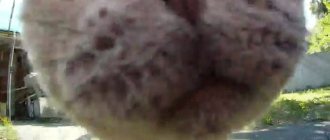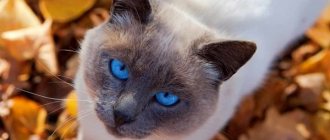The domesticated Serval is an extremely interesting and entertaining breed. These graceful creatures are one of the few cat families that belong to the wild. This explains their magnificent exotic color, non-standard habits and character traits.
They cannot be compared with ordinary cats, since servals require significant financial and time investments, careful study of the characteristics of the breed and a fairly serious approach.
Their owners are people with an exceptional love for cats and a desire to make friends with a reliable pet, which is quite capable of not only giving love to the owner, but also, if necessary, even protecting from danger.
The only thing is that when choosing a kitten, you need to contact trusted breeders and not skimp on your future furry friend.
History of the origin of the breed
The domestic serval is valuable because in appearance it looks exactly like a wild cat. Yes, in fact, he is a wild cat who decided to live in a nice mansion for a while. The homeland of the Serval cat is Africa. On the hot continent, their population, which was initially fairly large, has declined in recent years due to the fact that the beautiful fur of this cat attracts poachers.
Today there are 14 species of wild servals, which vary in coat color. Not long ago, breeders found out that the breed is perfectly domesticated (if you approach the matter wisely).
This is how domestic servals appeared.
You may also like the article about the Bengal cat.
Mistress of impressive animals
While I was admiringly looking at the living predator, a young, beautiful girl quietly approached me. She introduced herself in a pleasant voice: “I am Anna: the director of the Serval_family pet store, and part-time, the owner of charming creatures named Stephanie and Toby...”.
The owner and the cats were so remarkably similar to each other that I couldn’t resist showering them with compliments... Then I asked them to share with my readers the main secrets of raising African beauties.
Description of the Serval breed
The domestic Serval, as a proud representative of the “black” continent, gave his fans the opportunity to admire his African grace and predatory appearance. Yes, he is a predator, and his entire appearance is created in order to hunt and attack. The breed standard has not yet been fully developed, but some features have been recorded by nature itself.
- Serval kittens have a small head. But the ears, in comparison with the rest of the body, are large and set high, well-furred from the inside, on the outside they are covered with black and white stripes:
- the nose and bridge of the nose are wide;
- eyes almond-shaped below and boomerang-shaped along the upper eyelid;
- The pads under the vibrissae are pronounced, the vibrissae are obligatory, they are dense and long.
- The body size of the serval is small. Especially when compared with other wild cats in Africa. But compared to the usual domestic pussies, serval kittens are giants. Their body length can reach a meter.
The tail is thick and short (25-40 cm).
These cats are top models. Their limbs are the longest among all cats (in proportion to the body), the hind legs are longer than the front.
The listed differences are obvious, but this is not the entire list of the serval’s features. The weight of the “kids” is from 8 to 18 kg.
- The description of the serval's coat is similar to that of the cheetah. The animal is covered with spectacular spots that merge into stripes on the back. White coloring is visible on the chest, belly and muzzle. The color of the fur itself can be varied, ranging from sandy to reddish-brown.
The fur itself is short, unusually soft, thick and shiny.
Character
Servals are cats with character! And so that this character does not manifest itself in all its glory, it is necessary to as correctly as possible not allow the pet to show signs of wild ancestors.
African beauties love to play and run. Let them do both.
Since in nature they can even hunt birds, jumping up to 3 meters in height, they will not leave their habits at home. Be prepared for the fact that all the heights in your apartment will be conquered by a fearless serval. During the conquest process, antique vases, fragile figurines and paintings on the walls may be damaged.
In general, cats of this breed are very friendly and curious; they enjoy exploring and protecting their territory. Reviews of servals are unanimous that these cats are a bit of a dog!
African felines
Many years ago, bush cats lived throughout almost all of Africa. Only the Sahara Desert is not suitable for servals to live. They like to settle near bodies of water, avoiding dry, desert places.
Small bushes, tall grass, and forest edges serve as shelter and a source of food for rabbits, rodents, small antelopes, and are excellent hunting grounds for wild cats. Indeed, thanks to their long legs and flexible body, predators easily move among tall plants and freely look over the vegetation. African kittens do not like to run long distances, so they hunt stealthily: they track game in feeding or resting areas, and then jump to catch the victim.
Mammalian predators are excellent high jumpers and deftly catch flying birds. Wild beauties are night hunters. They have a sensitive sense of smell and hearing: quickly, without error, they hear rabbits or lizards underground and dig them out of their holes.
But the beautiful, short, silky to the touch, spotted fur of mini-cheetahs has become an object of human hunting.
According to the observations of zoologists, the serval population has noticeably decreased. The bush cat can now only be found in East and West Africa. Some subspecies of cats are listed in the Red Book.
Health
If you have a Serval kitten in your care, make sure that it does not jump from high surfaces - at a young age, their limbs are very fragile and there is a high probability of injury to their legs.
Keep an eye on your pet's stool. How to determine when it's time to sound the alarm? If such a nuisance as diarrhea occurs more than twice, this is a signal to immediately contact a veterinarian.
These cats need to be vaccinated, like any domestic four-legged animal.
IMPORTANT! The Serval vaccine must not contain active viruses. The price of a mistake is the life of the animal!
Serval marks territory. Sometimes up to 50 times an hour! Of course, this process is accompanied by an extremely unpleasant odor. So castration, in this case, is a necessity. Cats undergo sterilization at the age of 1 year, and males at 7-8 months.
The domestic serval lives longer than its wild counterpart. The lifespan of a domestic cheetah is 15-20 years.
Cost of a kitten
Purchasing and maintaining a Serval is a very expensive pleasure. You need to know this before purchasing. A serval in the house is a sign of wealth and status. But we should remember that this is not a soulless toy, but a vulnerable living creature.
The price of a kitten of this African predator is high. In Russia it starts from half a million rubles. In the United States of America, where most nurseries are located, it may be higher.
It is strictly forbidden to buy this cat from random people - there is a high probability of purchasing a sick animal from smuggled goods. To choose a kitten, you should come to the nursery yourself, talk with the breeder, make sure the health of the parents and baby, and deal with issues of proper nutrition and maintenance.
In our country, the rules for keeping wild animals at home are becoming stricter. Therefore, you need to make sure that the future pet is born from a female and a male located on the territory of Russia. Along with the kitten, you should receive its veterinary passport and certificate of origin.
1111
Care and maintenance
There are several simple techniques that allow you to raise a good-natured and safe animal from a Serval kitten. Thus, experts recommend hand-feeding the kitten - this way, the kitten will associate your appearance with pleasant emotions and will begin to feel safe in your presence.
Another good trick is to play with your baby while lying on the floor. When your eyes are at the same level, the serval does not perceive you as a threat.
Experts identify three basic rules in raising a serval:
- Don't let them play with your hands or feet;
- Don't yell at the cat, he understands commands perfectly. And definitely NEVER hit your pet. He won't forgive this;
- if it so happens that the serval cat starts playing and causes significant harm, then instead of an accusatory speech, just leave him alone. He will be inspired and come with repentance.
Feeding
The serval needs to be fed so that it does not yearn for the African savannah. In the wild, servals eat rodents (the majority of their diet), shrews, birds, and to a lesser extent snakes, lizards, and insects. Of course, you don't need to catch grasshoppers for your cat.
It is enough to create the right menu of raw meat with bones (this can be chicken, quail meat, offal) and, as a compliment from the chef, offer special vitamins with calcium supplements. Also provide ready-made super-premium food.
The daily food intake for an adult serval is up to 0.5 kilograms of meat.
Video
Photo
The domestic Serval cat is a prestigious animal, high-status and not cheap. Photos in royal interiors are the most successful in the African handsome man’s portfolio.
Not ready for such a cat? Take a closer look at the Siberian cat.
Conclusion about the breed
To get a correct idea of the character of African Serval cats, you need to understand how similar this breed is to dogs!
They easily begin to walk on a leash, with a certain amount of patience they begin to carry out even complex commands and are quite friendly with other animals... if they are the same size as them. In other words, you should not introduce a serval to a kitten or a parrot - hunting instincts will take over and only a serval will live in your house.
Representatives of this breed, in terms of harmfulness to furniture, are ready to cooperate with bark beetles - servals love to chew everything so much. And also tearing, turning over and overturning. In general, this cat needs space and a place to “walk”. Under no circumstances punish the serval for his pranks - this way you will achieve the exact opposite result, and you will also anger the luxurious kitty.
Be prepared for the fact that the Serval cat marks the territory about 50 times an hour and think about castration in time.
As a must, we can advise you to bathe your serval more often – they love water. But they don’t like scandals, so servals cannot be called stress-resistant.
Servals have no hereditary diseases.
Reviews from Serval breed owners
Julia : “I am a breeder of servals and I hasten to say that I have never met a more intelligent and elegant breed. My cats and cats understand commands very well. It’s enough to say in a confident voice: you can’t eat, go for a walk, go to the toilet - and the cats follow orders. African cats sleep in the same bed with us and they are quite friendly with each other. In general, the imperial breed!”
Olya : “Our Serval kitten scared me at first. We adopted him at the age of 5 months and he constantly hissed and growled at me and my husband. But then our patience and perseverance broke his bad character. Today he has stopped hiding in the corners of the house, plays with his toys and even sometimes goes to the restaurant with us!”
Ilya and Elena : “Our Asenka is our child. We spoil her all the time, and she takes advantage of it. Recently I myself made for her, it seems, a whole city instead of just one house. This is a multi-level complex in which our cat improves her hunting skills. We also take her on trips and Asya fits perfectly in all the hotels. There are no problems with this cat when traveling - she walks calmly on a leash and easily gets accustomed to a new litter box.”
Dog behavior
Mini-cheetahs behave like royalty: sedately and elegantly they take food directly from the hands, caress, rub their heads against the mistress’s legs, purr and say something during the meeting.
Africans purr in their own way: they either meow, or chirp, or even grunt in a hoarse voice.
Because of their dog’s devotion, good nature, love of water and constant desire to chew on everything, Anna calls the fluffies “cotops.” “Little ones” even love walking equipment: a harness with a leash.











